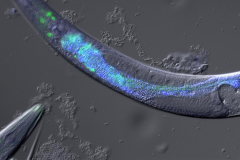Aspernig, H., Heimbucher, T., Qi W., Gangurde D., Curic S., Yan Y., Donner von Gromoff E., Baumeister R., Thien A.
Mitochondrial Perturbations Couple mTORC2 to Autophagy in C.elegans
Cell Rep
Kvainickas A., Nägele H., Qi W., Dokládal L., Jimenez-Organz A., Stehl L., Gangurde D., Zhao Q., Hu Z., Dengjel J., De Virgilio C., Baumeister R., Steinberg F.
JCell Biol.
Jiang YY., Maier W., Baumeister R., Minevich G., Joachimmiak E., Wloga Dr., Ruan Z., Kannan N., Bocarro S., Bahraini A., VasudeaBahraini A., Vasudevan KK., Lechtreck K., Orias E., Gaertig J.
LF4/MOK and a CDK-related kinase regulate the number and length of cilia in Tetrahymena
PLoS Genet
Weinberg, F., Schulze, E., Fatouros, P., Schmidt, E., Baumeister, R.* and Brummer, T. * (2014)
Expression pattern and first functional characterization of riok-1 in Caenorhabditis elegans,
Gene Exp Pattern * corresponding authors
Wolf, T., Q, W., Schindler, V., Runkel, E.D., and Baumeister, R. (2014)
Doxycyclin ameliorates a starvation-induced germline tumor in C. elegans daf-18/PTEN mutants.
Exp Gerontol. 2014 Apr 15. pii: S0531-5565(14)00123-5.
doi: 10.1016/j.exger.2014.04.002.
Runkel, ED., Baumeister, R., and Schulze, E (2014)
Mitochondrial stress: Balancing friend and foe.
Exp Gerontol. 2014 Mar 3. pii: S0531-5565(14)00070-9.
doi: 10.1016/j.exger.2014.02.013. Review
Cabello, J., Sämann, J., Gómez-Orte, E., Erazo, T., Coppa, A., Pujol, A., Büssing, I, Schulze, B, Lizcano, J.M., Ferrer*, I., Baumeister*, R., Dalfo, E. (2014)
pdr-1/hParkin negatively regulates the phagocytosis of apoptotic cell corpses in C. elegans.
Cell Death Dis. Mar 13;5:e1120. doi: 10.1038/cddis.2014.57. * cocorresponding authors

